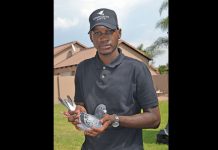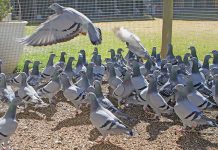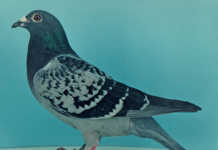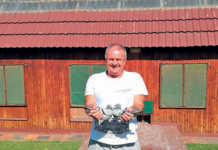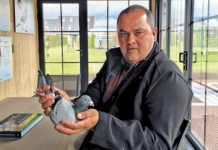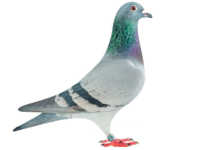This is a conclusion of the series on training advice for pigeon racing. By implementing a pre-prepared racing programme, we can safely conclude that the recipe for success in pigeon racing is entirely in human hands. The manipulation of form is a neglected necessity that warrants proper attention. It includes the following criteria:
Regular health checks – sick or slightly sick pigeons can’t be brought into peak condition. Regular visits to a vet are essential but if there isn’t a vet near you, do your own health check. Check for signs of disease in individual pigeons and isolate them immediately. Don’t allow stray arrivals to stay with the race team, but isolate them in a separate loft section.
Genetic training requirements – we have to study the full training programme of the pigeons we buy for breeding stock. Some pigeon families take either a short or long time to reach peak form and need to be trained for specific hours on the wing a day.
Some families remain constant in weight, while others are gluttons if the feed is readily available and pick up too much weight. Some families are genetically bred for fast-paced race events and others for the marathon races. If you don’t know the genetic requirements of the racers you own, strike a happy medium between soft and hard training until you have learnt which training system your pigeons require to give their best.
A basic requirement is that pigeons need daily exercise and proper road training – some champion fanciers loft-train their pigeons for an hour around the house twice a day, others train once day for an hour and others train three times a day for 30 minutes. Home training around the loft is alternated with road training at specific distances to get the pigeons fit and experienced. A pre-planned training schedule should be compiled before the season starts.
Focused training schedules – once we have learnt that our pigeons are more capable on either the sprints on the shorts or the tough longer distances, it’s wise to focus on the race conditions most suitable to the flock. We can’t alter the genetic demand of the flock. If, for example, we own a longer distance type, we can use the shorter distances merely as part of the training schedule to gradually get the pigeon fit and experienced for the long road. You may find an occasional all-rounder which performs in all conditions. It’s not a bad idea to use more of these in the breeding stock.
Managing time constraints – time constraints due to job schedules might make it impossible for many of us to loft- and road-train our pigeons as we should, without the help of family or staff. These assistants need to be properly trained to take care of the pigeons and maintain their fitness levels. The usual practice of many European businesspeople is to employ part- or full-time loft managers/trainers to do the job.
Manipulating form – manipulating form demands controlled wing hours, controlled feeding, supportive supplementation and motivation. The basic requirement in manipulating form is discipline. No energy should be wasted unnecessarily. Tough training includes road training against the wind, in the heat or both, to enhance form or to work off excess weight.
If working off weight isn’t the focus, then feeding must either be increased or supplemented after unexpected changes in the weather. Feeding should also be supplemented during an unexpected cold spell. The key principle to manipulating form is – more work, more food, less work less food.

